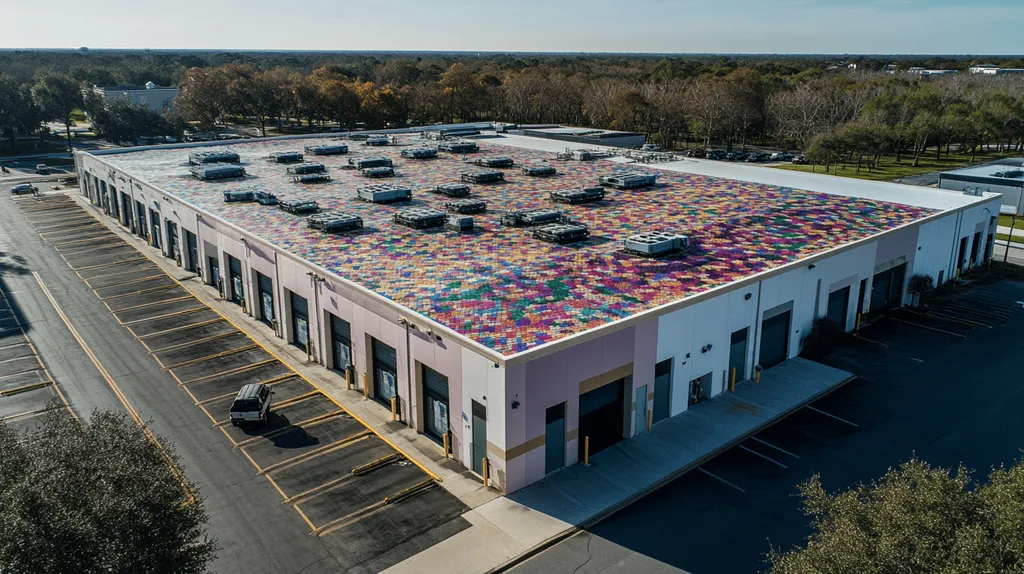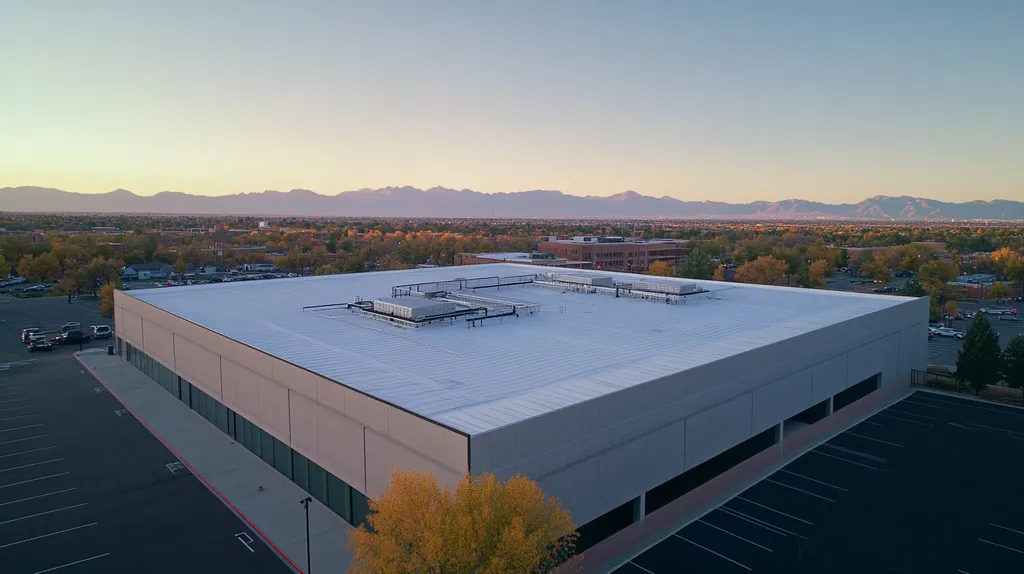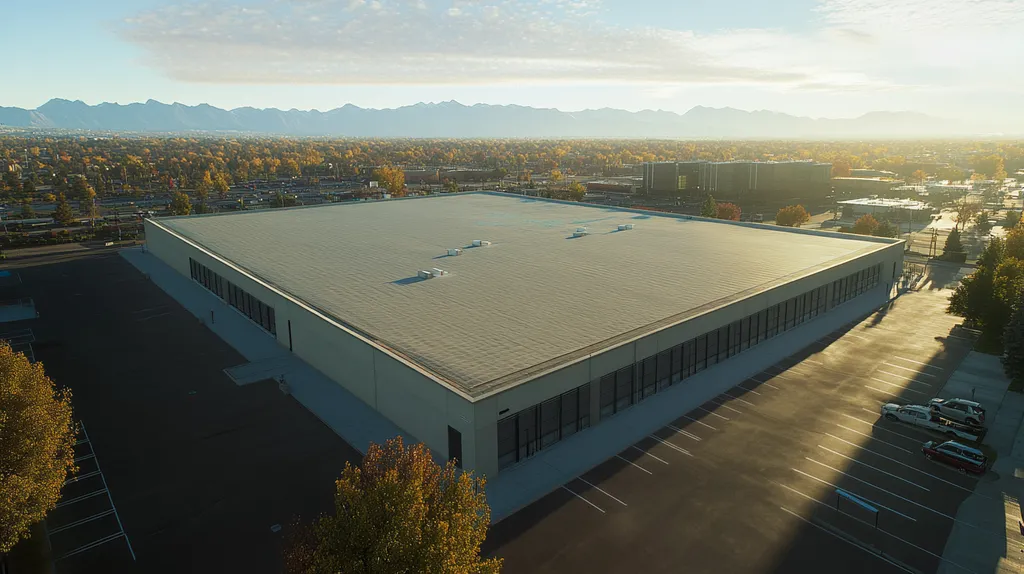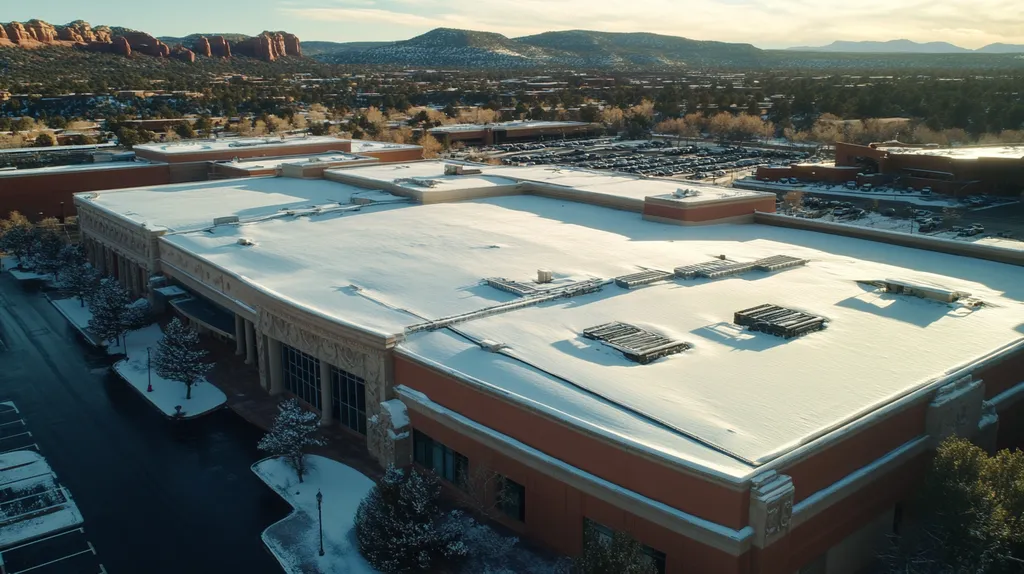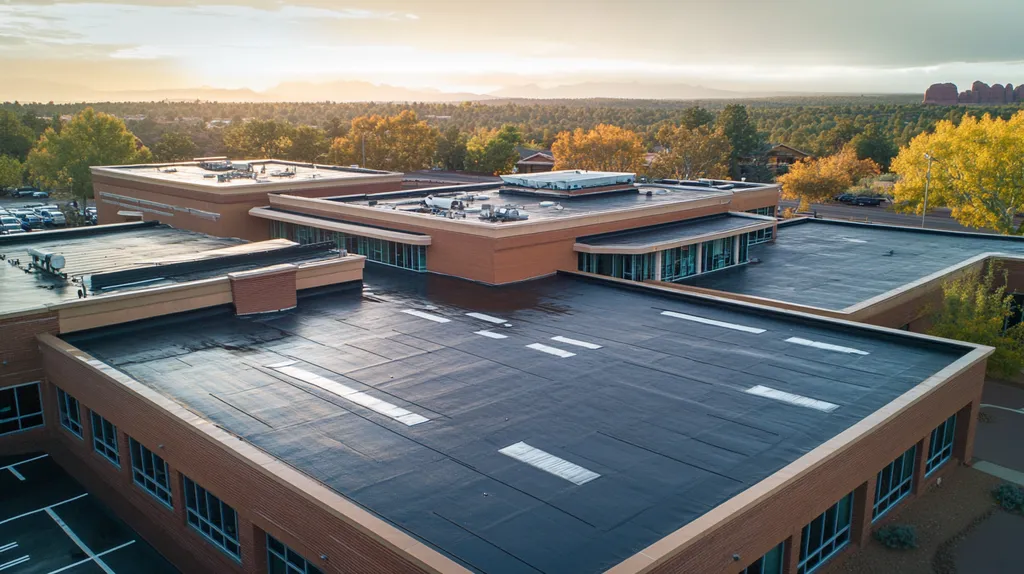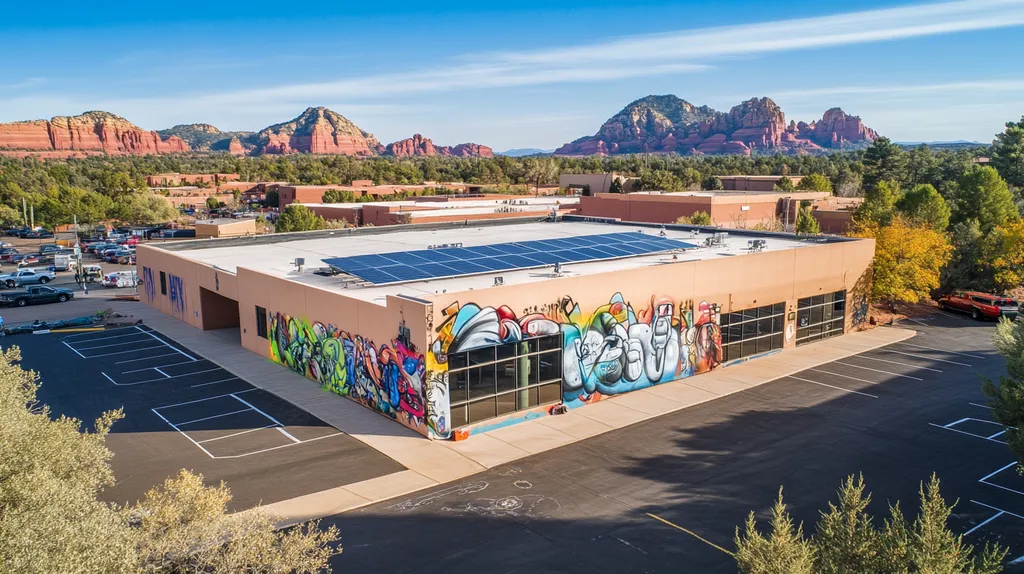Industrial facilities waste over $30 billion annually on excessive energy costs due to inefficient roofing systems, with some buildings losing up to 40% of their climate-controlled air through poorly designed or maintained roofs.
As utility rates continue climbing by 5-7% yearly, facility managers can no longer ignore this massive efficiency gap. Modern energy-efficient roofing solutions offer proven pathways to reduce HVAC loads by 20-30% while extending equipment life.
This comprehensive guide examines the critical components, implementation strategies, and optimization techniques that transform industrial roofs from energy liabilities into high-performance assets.
SECTION 1: FUNDAMENTAL CONCEPTS
Industrial roofing represents one of the largest untapped opportunities for energy savings in commercial buildings. Studies show that inefficient roofs can account for up to 40% of a building’s total energy loss, directly impacting operational costs and environmental footprint. Understanding core energy efficiency concepts isn’t just about compliance – it’s about capturing significant cost savings while future-proofing facilities against rising energy costs and stricter regulations.
Energy Efficiency Basics
Energy efficiency in industrial roofing starts with understanding heat transfer through the building envelope. The roof typically represents 20-30% of the total building surface area, making it a critical component in managing energy consumption.
Modern roofing systems use multiple layers of specialized materials to control heat flow. The combination of proper insulation, reflective surfaces, and air barriers can dramatically reduce the energy needed for heating and cooling.
Thermal bridging through metal fasteners and gaps in insulation can compromise even the best roofing materials. Proper installation techniques and attention to these details can prevent up to 70% of common energy efficiency losses.
The return on investment for energy-efficient roofing typically occurs within 3-7 years through reduced utility costs. Additional benefits include extended HVAC equipment life and improved indoor comfort for building occupants.
Cool Roof Principles
Cool roofs work by reflecting solar radiation and emitting absorbed heat back into the atmosphere. This simple principle can reduce roof surface temperatures by up to 60°F compared to traditional roofing materials.
The effectiveness of cool roofs is measured by two key metrics: solar reflectance and thermal emittance. Higher values in both categories translate directly to better energy performance and lower cooling costs.
Material choices range from specialized white membranes to advanced ceramic coatings. Each option offers different benefits in terms of cost, durability, and energy performance, allowing customization for specific facility needs.
During peak summer conditions, cool roofs can reduce air conditioning demands by 10-30%. This reduction directly impacts utility bills and helps extend the service life of HVAC equipment.
Thermal Performance Fundamentals
Thermal performance encompasses how well a roof system manages heat flow throughout the year. The key components include insulation R-value, air barrier systems, and thermal mass properties of roofing materials.
Professional energy modeling can predict annual savings based on local climate conditions and building use patterns. These calculations help facility managers justify investment in higher-performance roofing systems.
Continuous insulation systems eliminate thermal bridges and provide superior performance compared to traditional approaches. This technology can improve overall roof thermal performance by 25-40% compared to conventional installations.
Regular thermal imaging and performance monitoring ensure roofing systems maintain their efficiency over time. Early detection of thermal performance issues can prevent significant energy waste and extend roof service life.
SECTION 2: SYSTEM COMPONENTS
Modern industrial roofing systems represent a critical intersection of material science and energy management. With rising utility costs threatening operational budgets, choosing the right roofing components can reduce energy consumption by up to 30%. Understanding these key system elements helps facility managers make informed decisions that impact both immediate operations and long-term sustainability goals.
Reflective Roof Membranes
Cool roofs have emerged as a cornerstone technology for reducing energy consumption in industrial buildings. These specialized membranes reflect more sunlight and absorb less heat than standard roofs, dramatically reducing cooling energy demands and improving indoor comfort. (source: US Environmental Protection Agency)
High-performance reflective membranes can reduce surface temperatures by up to 80°F compared to traditional black roofs. This temperature reduction translates directly to lower cooling costs, particularly during peak demand periods.
Modern reflective membranes incorporate advanced polymers that maintain their reflective properties for 15-20 years. This durability ensures consistent energy performance while minimizing maintenance requirements.
Installation costs for reflective membranes typically run only 5-10% higher than traditional roofing, while delivering energy savings that can exceed 25% annually.
Thermoplastic Polyolefin (TPO) Systems
TPO systems combine superior weathering resistance with exceptional energy performance. Their engineered surface maintains high reflectivity even in industrial environments where air pollution and chemical exposure can degrade other materials.
The molecular structure of TPO creates a naturally reflective surface that doesn’t require additional coatings. This characteristic ensures consistent performance throughout the membrane’s entire service life.
Heat-welded seams create a monolithic surface that eliminates thermal bridges and air infiltration. This seamless integration enhances both energy efficiency and weather resistance.
The material’s flexibility and strength allow it to accommodate building movement without compromising performance. This resilience translates to fewer repairs and consistent energy savings over time.
Green Roof Systems Overview
Vegetative roof systems deliver multiple energy efficiency benefits through natural processes. The combination of plant material and growing medium provides superior insulation value while actively cooling through evapotranspiration.
Modern green roof assemblies can reduce heat transfer by up to 75% compared to conventional roofing. This dramatic improvement stems from the combined effects of thermal mass, insulation, and natural cooling.
Structural requirements for green roofs have decreased with new lightweight growing media and drainage systems. These innovations make retrofitting existing buildings more feasible and cost-effective.
Advanced irrigation and monitoring systems ensure optimal plant health while minimizing maintenance requirements. These automated solutions help maintain peak energy performance with minimal operational oversight.
SECTION 3: IMPLEMENTATION METHODS
Implementation of energy-efficient roofing demands precision and expertise to deliver measurable utility savings. Studies show that poor installation practices can negate up to 50% of potential energy savings, even with premium materials. Strategic implementation combining proper design, skilled installation, and quality control protocols ensures maximum return on investment while minimizing operational costs.
Design Considerations for Energy Efficiency
Energy-efficient roofing systems reflect more sunlight and absorb less heat than standard roofs, dramatically reducing cooling demands and HVAC strain. This reflective capability creates more consistent indoor temperatures while lowering operational costs. (source: True Colors Industrial)
Proper drainage design prevents water accumulation that can degrade insulation performance. Strategic placement of roof penetrations and careful detailing around equipment curbs minimizes thermal bridging.
Wind uplift calculations inform membrane attachment patterns and perimeter enhancement requirements. These specifications ensure long-term performance while maintaining thermal efficiency.
Climate-specific design factors like snow loads, UV exposure, and temperature extremes guide material selection. These considerations help optimize energy performance across seasonal changes.
Installation Techniques for TPO and EPDM
Successful membrane installation begins with proper substrate preparation and moisture testing. Even minor surface contamination can compromise adhesion and reduce system longevity.
TPO installations require calibrated hot-air welding equipment and skilled technicians. Proper heat settings and consistent pressure ensure watertight seams that maintain thermal performance.
EPDM systems demand precise adhesive application and careful management of flash-off times. Proper sheet positioning and sequential bonding prevent wrinkles that could compromise insulation effectiveness.
Quality control measures include pull testing of membrane seams and detailed inspection of penetration details. Regular verification during installation prevents costly repairs and energy waste.
Roof Coating Application Guidelines
Surface preparation determines coating adhesion and long-term performance. Power washing and proper primers create optimal bonding conditions for maximum reflectivity.
Application temperature and humidity significantly impact coating cure times and final properties. Monitoring weather conditions ensures proper film formation and maximum energy benefits.
Multiple thin coats provide better coverage and durability than single thick applications. This approach minimizes pinholes and ensures consistent thermal performance.
Regular thickness measurements during application verify proper material coverage. Documentation of application conditions supports warranty compliance and performance validation.
SECTION 4: MAINTENANCE REQUIREMENTS
Maintaining energy-efficient roofing systems demands vigilant attention to prevent catastrophic utility cost increases. Studies show that neglected roofs can lose up to 40% of their energy-saving capabilities within just five years. While many facility managers focus on installation, it’s the ongoing maintenance that determines whether energy efficiency promises translate into actual utility savings.
Regular Inspection Protocols
Effective roof inspections require systematic evaluation of critical energy-efficiency components. Regular assessments should occur bi-annually at minimum, with additional checks following severe weather events.
Digital imaging technology now enables precise tracking of thermal performance degradation. Infrared scanning can detect insulation failures and moisture infiltration before they impact utility bills.
Surface cleanliness directly affects energy performance, particularly with reflective roofing materials. Accumulated dirt can reduce solar reflectance by up to 30%, dramatically increasing cooling costs.
Documentation of inspection findings creates valuable performance trending data. This information helps predict maintenance needs and optimize energy efficiency investments.
Repair Strategies for Leaks and Damage
Regular maintenance, including cleaning, inspections, and immediate repairs, is essential to sustain the performance of energy-efficient roofing systems. Preventative maintenance scheduling helps catch potential problems early, reducing costly damage and utility expenses. (source: US Environmental Protection Agency)
Repairs must maintain system continuity to prevent thermal bridging. Even small penetrations can compromise insulation effectiveness and create energy-wasting heat transfer paths.
Membrane patches should match original material specifications to maintain consistent performance. Using inferior repair materials can create weak points in the thermal barrier.
Quality control measures during repairs protect long-term energy efficiency. Thermal imaging verification ensures repairs maintain the roof’s intended performance characteristics.
Preventative Maintenance Scheduling
Strategic maintenance scheduling aligns with seasonal energy demands. Summer preparations focus on maintaining reflective properties, while winter readiness emphasizes insulation integrity.
Automated monitoring systems now enable predictive maintenance scheduling. Real-time performance data helps identify efficiency losses before they impact utility costs.
Coordinating maintenance with equipment service schedules minimizes roof traffic. This reduces the risk of damage while ensuring HVAC systems operate at peak efficiency.
Budget planning should account for both routine maintenance and performance restoration. Regular investment in preventative care yields substantial returns through sustained energy savings.
SECTION 5: PERFORMANCE METRICS
Tracking roofing system performance has become critical as energy costs continue to surge, with some facilities seeing utility bills increase by 30% annually. Without proper metrics, even the most advanced energy-efficient roofing solutions can underperform by 25-40%. Understanding and implementing the right performance measurements helps facility managers validate investments, optimize operations, and capture maximum energy savings while avoiding costly oversights.
Energy Consumption Monitoring Tools
Modern roofing performance monitoring combines thermal imaging, real-time sensors, and data analytics to provide unprecedented visibility into system efficiency. These tools detect issues weeks or months before they would become visible through traditional inspections.
Smart monitoring systems can track temperature differentials across roof surfaces, identifying areas where insulation may be failing or where thermal bridges are developing. This early detection prevents energy waste while extending roof life.
Energy consumption monitoring should integrate with building automation systems to correlate roof performance with HVAC loads. This integration helps quantify actual savings and optimize system settings.
Regular calibration and maintenance of monitoring equipment ensures accuracy. Even small sensor drift can mask significant performance changes that impact energy costs.
Cost Savings Analysis Methods
Energy-efficient commercial roofing systems deliver multiple financial benefits through reduced energy costs, improved occupant comfort, and extended roof lifespans. These savings compound over time as utility rates continue to rise and building efficiency standards become stricter. (source: RoofCrafters)
Effective analysis requires establishing clear baseline measurements before upgrades. This data provides the foundation for accurate ROI calculations and performance validation.
Monthly utility bill analysis should factor in weather normalization to ensure accurate year-over-year comparisons. This adjustment prevents seasonal variations from skewing results.
Life-cycle cost analysis must include maintenance savings, extended equipment life, and potential utility incentives. These factors often double or triple the apparent ROI.
Environmental Impact Assessment
Carbon footprint calculations for roofing systems must consider both direct energy savings and indirect benefits like reduced urban heat island effect. These combined impacts often exceed initial projections.
Environmental assessments should track reductions in greenhouse gas emissions from decreased HVAC usage. Many facilities find these metrics valuable for sustainability reporting and marketing.
Impact studies must account for the embodied carbon in roofing materials and installation processes. This complete analysis helps optimize material choices for maximum environmental benefit.
Regular environmental performance reviews help identify opportunities for additional improvements. These assessments often reveal synergies with other sustainability initiatives.
SECTION 6: OPTIMIZATION STRATEGIES
Industrial facility managers face a critical challenge as energy costs continue to surge, with utility expenses now consuming up to 30% of operational budgets. Without strategic roof optimization, buildings hemorrhage thousands in preventable energy costs monthly. The Department of Energy estimates that optimized industrial roofing can reduce total facility energy consumption by 15-25% annually, making roof enhancement one of the highest-ROI energy efficiency investments available.
Upgrading Existing Roofs for Efficiency
Energy-efficient roofing systems reflect more sunlight and absorb less heat than standard roofs, dramatically reducing cooling demands and HVAC strain. This reflective capability creates more consistent indoor temperatures while lowering operational costs. (source: True Colors Industrial)
Strategic upgrades begin with comprehensive thermal mapping to identify weak points and prioritize improvements. These assessments often reveal that even minor enhancements to insulation and reflective coatings can yield 10-15% immediate energy savings.
Air barrier improvements represent another critical upgrade opportunity. Sealing roof-wall junctions and penetrations can prevent up to 40% of current energy losses while extending insulation life.
Modern coating systems can transform existing roofs into high-performance assets without full replacement. These solutions typically deliver 5-7 year payback periods through reduced cooling costs.
Introducing Solar Panels and Daylighting
Rooftop solar integration requires careful planning to maximize both energy generation and roofing system longevity. Professional assessments evaluate structural capacity, orientation, and shadowing patterns to optimize panel placement.
Modern solar mounting systems distribute loads evenly while maintaining roof membrane integrity. These engineered solutions prevent thermal bridging and moisture infiltration that could compromise energy efficiency.
Strategic daylighting through properly sealed and insulated skylights can reduce lighting costs by 25-40%. Advanced prismatic designs minimize heat gain while maximizing natural light transmission.
Integration of solar and daylighting systems must account for local climate conditions and facility operating schedules. This optimization ensures maximum return on investment through reduced peak demand charges.
Energy Efficiency Certification Processes
Certification programs provide structured frameworks for evaluating and improving roof system performance. These programs typically examine thermal efficiency, material sustainability, and long-term maintenance requirements.
Documentation requirements drive systematic performance tracking that helps identify optimization opportunities. Regular monitoring ensures sustained energy savings while supporting continuous improvement efforts.
Many certification programs offer tiered achievement levels that align with different budget capabilities. This flexibility allows facilities to implement improvements incrementally while working toward higher certifications.
Certified buildings typically command 7-10% higher lease rates and maintain better occupancy levels. These market advantages often justify certification costs within 2-3 years through increased property value.
The Bottom Line
With industrial facilities wasting over $30 billion annually on excess energy costs, implementing efficient roofing solutions has become a critical business imperative.
Modern roofing technologies can reduce HVAC loads by 20-30% while extending equipment life, yet 70% of facilities continue operating with outdated, inefficient systems.
The combination of rising utility rates, stricter environmental regulations, and proven ROI makes energy-efficient industrial roofing one of today’s most compelling facility investments.
Success requires careful attention to system selection, proper installation, regular maintenance, and performance monitoring – but facilities that execute effectively can expect to see utility savings of 15-25% annually while future-proofing against escalating energy costs.
The time for industrial facilities to act is now, as every month of delay means thousands in preventable energy waste.
FREQUENTLY ASKED QUESTIONS
Q. What is energy efficiency in commercial roofs?
A. Energy efficiency in commercial roofs refers to minimizing heat loss or gain. The goal is to reduce energy consumption for heating and cooling, leading to lower utility bills and a smaller environmental footprint.
Q. How do reflective roof membranes contribute to industrial roofs?
A. Reflective roof membranes lower cooling energy demands by reflecting sunlight. This helps maintain comfortable indoor temperatures and can lead to significant savings on air conditioning costs during peak periods.
Q. What installation techniques are essential for an industrial roof?
A. Proper installation techniques such as substrate preparation and moisture testing are critical. Ensuring watertight seams and precise adhesive application can prevent energy loss and maintain the integrity of the roofing system.
Q. How important is maintenance for energy-efficient roofing?
A. Regular maintenance is crucial to sustain energy efficiency. Ignoring maintenance can result in a significant drop in performance, leading to increased utility costs and potential structural issues over time.
Q. What performance metrics should be tracked for industrial roofs?
A. Essential metrics include energy consumption, temperature differentials, and monitored performance trends. These help facility managers understand efficiency and identify areas for improvement, ensuring continued cost savings.
Q. What are effective strategies for optimizing industrial roofs?
A. Strategies include upgrading insulation, adding reflective coatings, and utilizing renewable energy solutions. Implementing these can significantly lower energy costs and enhance overall roof performance over time.
Q. Can green roofs help with energy efficiency in industrial buildings?
A. Yes, green roofs provide excellent insulation and cooling through evapotranspiration. They can significantly reduce heat transfer, leading to lower energy bills and improved thermal performance in industrial facilities.

